
views
X
Trustworthy Source
Mayo Clinic
Educational website from one of the world's leading hospitals
Go to source
However, some people may feel anxious about having a gynecological exam and possibly even put it off as a result. Those feelings are totally normal, but don't worry! By learning about what to expect at your gynecological exam, you'll likely feel more comfortable and prepared.
Preparing for Your Exam
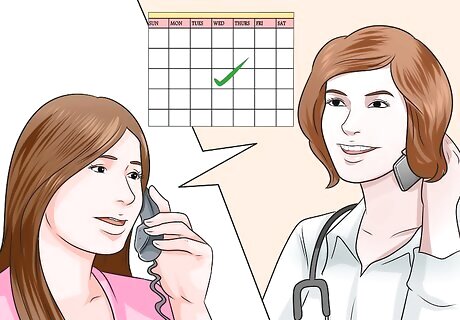
Schedule the appointment. Routine appointments should be scheduled at a time between your periods. The doctor will not be able to complete the full exam if you are on your period the day of your appointment. If you are having an urgent problem, let the office know that. Schedule for the first available appointment. Proceed with seeking the medical care you need. If this is your first gynecological exam, let the person scheduling the appointment know. The office may schedule the appointment differently to get started with your medical record, and accommodate any special needs for young people during their first exam. Note that routine gynaecological exams can be performed by family physicians (and generally are). There is no need to see a gynaecologist (a specialist) unless your family doctor suspects more severe concerns that require a higher level of medical training to be fully addressed. It is recommended to have your first gynaecological exam in your early twenties, or within three years of the onset of sexual activity (whichever comes first). The recommendations vary depending on location as it is a loose guideline, so if in doubt ask your family doctor at what age you should be seen for your first full exam. Be aware that any young adult or teen that is sexually active, having problems with their menstrual cycle, or has not started their cycle by the age of 16, should be seen for a routine gynaecological exam by their doctor.

Bathe or shower as you normally would. Take your bath or shower within 24 hours of your appointment, and avoid using products you would not normally use. Avoid sexual intercourse for 24 hours before the exam. Irritation from sexual activity may cause some of the test results to be difficult to interpret. Avoid feminine products prior to the exam. Do not douche or use any feminine deodorants, sprays, or creams for 24 hours before the appointment. Dress appropriately. Remember you will be removing your clothes. Try to avoid wearing clothing that is hard to get in or out of.

Bring a friend. If it makes you feel more comfortable, bring a family member, such as your mother or older sister, or a friend with you. Your family member or friend can stay in the waiting area, or go through the entire exam with you.

Prepare your questions. This is your chance to ask anything about your sexual and reproductive health. That includes questions about birth control, safe sex practices, sexually transmitted diseases, changes about your body, and what to expect in the future.
Discussing Your Health History
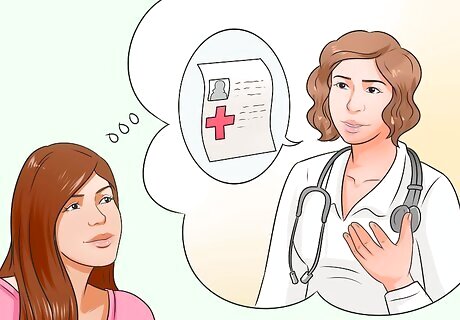
Expect questions about your general medical history. Answer thoroughly and honestly. Your doctor needs to have as much information as possible in order to effectively treat any existing problems, and work with you to prevent future complications. Some medical offices will have you answer questions about your medical history by filling out forms, while others may do this in person. Be prepared to discuss your sexual history. Your doctor will need to know if you are sexually active. They may ask about breast, abdominal, vaginal, or sexual problems, that you don’t think are normal. That includes being taken advantage of sexually, or sexual abuse. Your doctor will also ask about your current and past use of contraceptives.
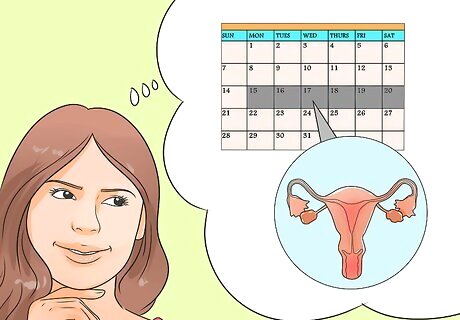
Anticipate questions about your period. Be able to tell the nurse or doctor the first date of your most recent period, and the age when you had your first period. They may also ask the age that your breasts began to develop. They will ask if your periods are on a regular cycle, such as every 28 days, how long they usually last, and if you have any problems, like bad cramps, while you have your period. They will ask if you have episodes of spotting, or bleeding, between your periods. They will likely ask how heavy you bleed during your periods. You can usually answer this by telling them how many pads or tampons you need to use, especially for the first 48 hours of your cycle.
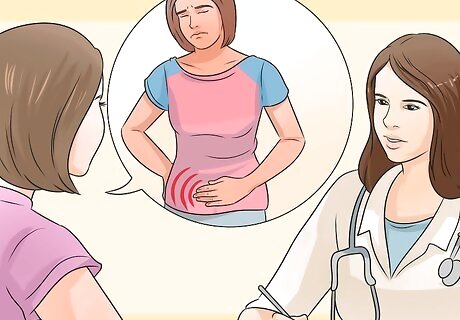
Provide information about any problems you are having. This may include unusual vaginal discharge, bad odor, itching in your vaginal area, unusual pain or discomfort in your abdomen or vaginal area, pain during sex, and any changes, pain, or problems with your breasts. Your doctor has the option to order STI (sexually transmitted infection) testing for you if either you or your doctor has a concern. A urine test can be done for chlamydia and/or gonorrhoea, and a blood test for HIV, herpes, and/or syphilis. There is no harm in undergoing STI testing if you have any concern at all, as there are effective treatments available if you do have an infection, and treating it sooner rather than later can help to avoid long-term complications. For instance, treating chlamydia and/or gonorrhea from the outset prevents the long-term development of PID (pelvic inflammatory disease), which is when the infection has been around for a while and can lead to other complications like fertility issues down the road or the development of chronic pelvic pain. Your health care provider can test for trichomonas, gonorrhea, and chlamydia using a urine sample.

Tell the doctor if you think you are pregnant. Urine or lab work will be done to confirm the pregnancy. If your pregnancy is confirmed, your appointment will include additional steps and your doctor will help to arrange for your obstetrical care all the way through delivery.
Undergoing the Exam

Ask your doctor to explain the procedures. Parts of the exam can feel awkward. Talking to your doctor during the exam can help you to feel more relaxed. Ask the doctor to explain what they are doing as they are doing it. If you are being examined by a male doctor, a female nurse will be with you at all times during the exam. If one is not present in the room, ask for a nurse to be with you. The external areas will be examined, then an internal exam will be done. The external areas examined include the clitoris, labia, vaginal opening, and rectum. The internal exam includes the use of a speculum to check the vaginal canal, cervix, perform the Pap smear, and take other tissue samples if needed. A digital exam is performed to feel the uterus and ovaries. However, the internal exam may not be necessary if you have never been sexually active. Make sure to let your doctor know if you are uncomfortable with the internal exam. If you have been sexually abused, then it may take several visits before you will feel comfortable with this type of exam. Be sure to communicate your concerns with your doctor. The entire exam takes only a few minutes.

Remove your clothes. After the routine tests and medical questions are completed, you will be given a gown and asked to undress. Remove everything, including your panties and your bra, unless the nurse tells you otherwise.

Put on the gown. Gowns used for gynecological exams have openings in the front. This allows your doctor to examine your breasts. Much of the time, the gowns used are made of paper. An additional paper cover may be provided that goes over your lap.
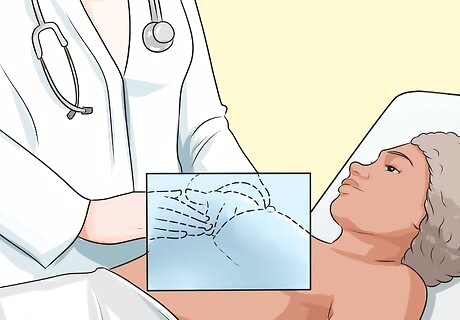
Have the breast exam. The breast exam comes first. The doctor will touch your breasts and move their hands in a circular and linear motion. The doctor will check the breast tissue that extends up into your armpit area. Your doctor will also check your nipples for any abnormalities. The breast exam is done to check for any lumps or abnormalities. If you feel any discomfort during this procedure you should tell the doctor.
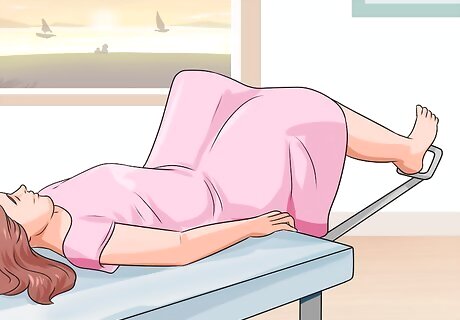
Slide to the end of the table. You will need to position yourself so your feet can fit into holders, called stirrups. This allows your legs to be spread apart to aid in the next parts of the exam. Relax your legs and let them fall open.

Have the external exam. The external exams allows the doctor to examine the area for any signs of irritation, infection, or abnormalities in the tissues surrounding your vagina and urethra, which is the duct that allows you to pass urine from your bladder. The doctor will examine the area visibly, and may touch tissues in the area to examine them more closely. For example, if your labia is red or inflamed, the doctor may spread the labia to examine for any abnormalities.
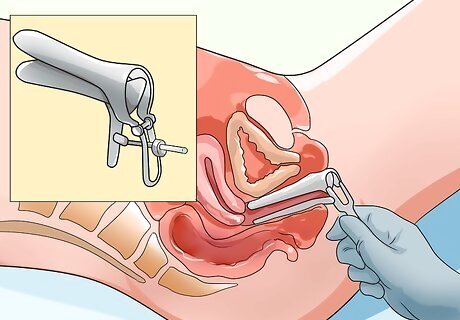
Expect some pressure from the speculum. Next, the doctor will insert an instrument called a speculum. The speculum may be plastic or metal. A metal speculum may feel cold as it is inserted. This will slide into your vagina, then will be gradually opened to allow the doctor to examine the vaginal canal and cervix. This causes a feeling of pressure but should not be painful. If you feel pain, tell the doctor. Speculums come in different sizes, so another one can be tried if the first one is causing you pain.
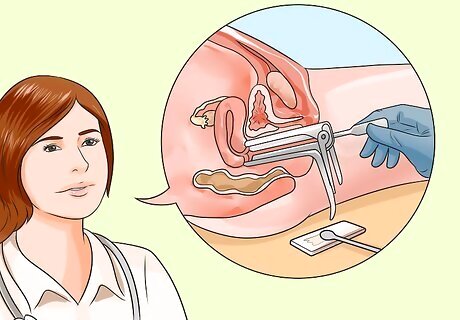
Know what the Pap test is. After the doctor has examined your cervix and vaginal canal, they will insert a small swab or brush, through the opening in the speculum, to remove some of the cells from your cervix. This is called a Pap test and is not recommended before the age of 21. The sample taken will be sent to a lab and examined for any cells that look abnormal or cancerous. Most people have perfectly normal Pap tests. Typically, you will be notified of the test results from your Pap smear within 10 to 14 days. If you are having any problems, the doctor may take additional samples to be reviewed by a laboratory.
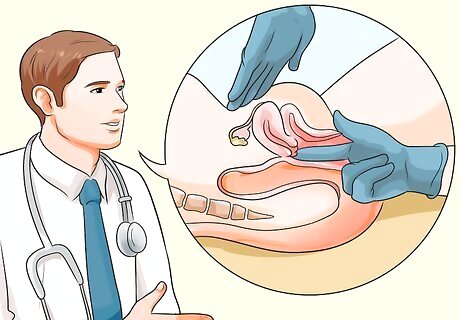
Understand the digital exam. The next part of the exam will involve the doctor sliding one or two fingers into your vagina, and applying pressure to your abdomen. This is done so the doctor can feel for any lumps or abnormalities around your ovaries and female organs including your cervix, fallopian tubes, and uterus.

Talk with your doctor before you leave. Once the exam is complete, you will remove the gown and get dressed. The nurse may escort you to the doctor’s office or a consultation area, or the doctor may review your exam with you in the room. The doctor will review your exam results with you, and answer any remaining questions you may have. They will also provide you with any written prescriptions that are needed, such as a prescription for birth control pills.
Continuing Your Care
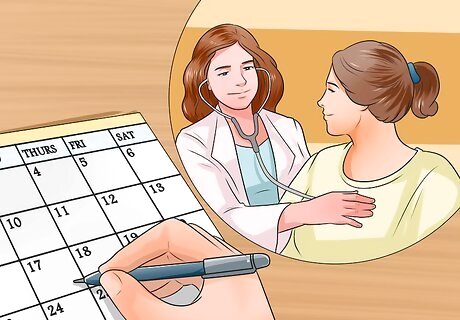
Ask your doctor when to book your next appointment. Tests such as the Pap smear are generally done once every two years; however, for people just starting out, it is recommended to undergo Pap testing yearly to establish a healthy baseline. Ask your doctor when you should return for your next routine exam. Note that, if there are any abnormal results on your Pap test (or in other parts of the breast or reproductive exam), your doctor may ask you to return sooner for follow-up care or additional tests.

See you doctor sooner if you have problems. Problems like abdominal pain, vaginal discharge or wetness, burning sensations, an unusual or strong odor, severe menstrual cramps, or spotting between periods, warrant making an appointment. You can also see your doctor sooner if you have other reproductive questions that come up, such as a desire to start birth control pills, questions around safe sex and/or sexually transmitted infections, or questions surrounding pregnancy. Once you become sexually active, your doctor can guide you in selecting the best type of birth control for you. This may include prescription products that your doctor can prescribe for you. The doctor will help monitor their use. Common forms of birth control include oral contraceptives, or birth control pills, patches, injections, condoms, vaginal devices like diaphragms, and intra-uterine devices, or IUDs. Remember that your doctor is trained to provide people with the information they need to make the best choice for them in any area of reproductive health, so your doctor will always be willing to see you and offer you advice even if it is only around sexual health questions you may have and not for a routine exam.

Perform breast exams yourself. Your doctor will show you how to check your own breasts for lumps that may be cancerous, or otherwise of concern. Perform these exams regularly, and notify your doctor as soon as possible if you think you have felt a nodule or small bump inside your breast tissue.

















Comments
0 comment